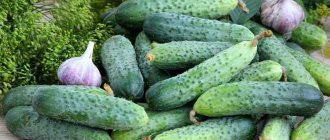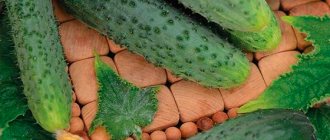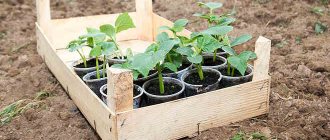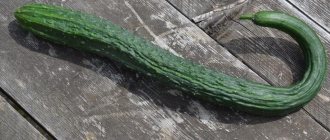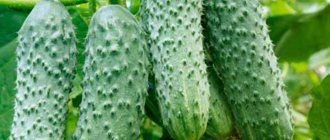Cucumber Bastion F1 will appeal to gardeners, summer residents and small farmers. Its fruits are indispensable on the summer table; they can be canned and salted so that you can eat crispy, beautiful cucumbers in winter, and can also be grown for sale.
| Landing location | Ripening time | Mode of application | Fruit length | Group | Fruit smoothness | Pollination method |
| Universal | Early ripening (35-45 days) | Universal | Medium - from 10 to 15 cm | Hybrid | Highly lumpy | Parthenocarpic |
Description of the cucumber variety Bastion
By sowing parthenocarpic Bastion cucumbers, you can be sure of a good harvest. The variety has a well-developed root system, regardless of the type of soil, spreads widely in search of nutrients and provides them with vigorous growing vines. Cucumber Bastion is of an indeterminate type and requires mandatory formation. After pinching, the announced number of greens is collected. Cucumber stems are powerful and have medium branching. The foliage is normal. Flowers of the female type, with an ovary.
Description of fruits
The medium-sized fruits of the Bastion f1 cucumber are pimply, with large and frequent tubercles, randomly located along protruding stripes on the dark green skin. The pimples visually end with thorns characteristic of cucumbers; in this variety they are white. The length of the fruit at technical ripeness is 12-15 cm. The diameter of the fruit is from 3.5 to 4.5 cm. The average weight of harvested cucumbers is from 130 to 160 g.
There are no internal cavities. The pulp of the Bastion variety is elastic, juicy, and habitually crunchy when eaten. Cucumbers retain their natural color and do not turn yellow. The taste is pleasant, the skin and pulp are not bitter. Bastion cucumbers can be harvested in the gherkin stage, when they weigh 90-95 g.
Characteristics of the variety
Hybrid Bastion is hardy thanks to powerful roots that adapt well to various types of soil.
Productivity and fruiting
The success of the Bastion variety lies in its early ripening. Cucumbers are ready for harvesting already on the 40-45th day of bush development. If the seeds are planted directly into the soil, wait until it warms up to 15 °C. In different regions this is the end of April or May. The Bastion cucumber harvest will ripen in less than 1.5 months after germination, by the end of June or mid-July. In a heated greenhouse, sowing dates are regulated by gardeners.
The cucumber of the Bastion variety has bouquet-type ovaries; up to 6 fruits are created in a node. From a bush they collect from 5 kg. Productivity increases when all agricultural technology requirements are met, including proper cane formation, regular watering and fertilizing. Greater harvest of cucumbers in the greenhouse, since the room maintains comfortable temperature conditions for the plant. The ovaries grow larger if the greens are regularly collected: gherkins every other day, and larger fruits for pickling - after 2-3 days. Severing the fruit stimulates the plant to form new cucumbers. It is always noted that the hybrid bears fruit even in conditions of temperature changes and tolerates cool weather well.
Application area
Elastic, tasty Bastion f1 cucumbers, judging by reviews, are used with pleasure for fresh salads. They are salted, pickled, canned. Dense, void-free pieces of cucumber are cut for quick freezing.
Resistance to diseases and pests
Hybrid Bastion is higher in yield because it is immune to the common fungal disease cladosporiosis or brown (olive) spot. It is also not affected by the cucumber mosaic virus. The Bastion variety is moderately resistant to powdery mildew pathogens. In greenhouses, if not properly cared for, cucumbers can be attacked by aphids or whiteflies. First, they try folk remedies or use insecticides.
Advantages and disadvantages of the variety
In reviews of Bastion cucumbers, summer residents name the distinctive features of the variety:
- early ripeness;
- friendly return of the harvest;
- endurance to weather stress conditions: drought and cold resistance;
- high commercial properties;
- versatility in growing and using fruits.
Many people believe that the disadvantage of Bastion cucumbers is that the hybrid produces a low yield, less than 10 kg per 1 square meter. m.
Features of cultivation
The vegetable grows well both in open ground and in spring greenhouses or under film covers. Planting of Forsage F1 cucumbers can be carried out from the North-Western to the Far Eastern regions.
Landing
Depending on where the plant is planted, the planting will also change. Greenhouse procedures should be carried out in early March. The seeds are lowered into the hole to a depth of about 3 cm. Immediately after sowing, you need to water them with warm water. There should be a gap of about 40-50 cm between future bushes.
It is better to use containers for planting so that later when picking, you do not damage the fragile roots of the plants, otherwise the seedlings may die or develop incorrectly.
Work on unprotected soil should begin in early May, focusing on warming up the soil. It is necessary to clear the ground of weeds in advance and apply fertilizing. It is customary to use mineral phosphorus fertilizers before planting to improve the properties of the soil.
Watering should not be excessive. The distance between the holes is 40-45 cm: this will allow the bushes not to get tangled and the fruits will have enough space for growing. You need to leave at least 60 cm between the rows to make harvesting convenient.
Basic care includes watering and fertilizing. The soil needs to be loosened and fertilized regularly. Both roots and shoots need nutrition. A nourished root system will help the plant to fully develop. The second feeding is needed so that the stem receives all the necessary nutrients.
Rules for planting and care
Unpretentious to weather conditions, the hardy variety Bastion is planted directly into holes in the garden. If you want to grow an early harvest of cucumbers, 2-3 weeks faster, use the seedling method.
Planting seedlings
Cucumber seedlings develop quickly. 3 weeks after germination, the seedlings are already moved to the site. For a vegetable garden or film shelter without heating, cucumber seeds are planted in mid-April. The grains are processed and packaged at the originator’s company’s enterprises: for Bastion hybrid seeds, gardeners do not carry out pre-sowing preparation. In the fall, they stock up on substrate if they do not purchase ready-made soil for seedlings. Take equal parts of garden soil and humus, add peat and sand to make the substrate loose. For nutritional value, the soil in the container is spilled with a ready-made preparation for fertilizing “Universal” or “Kemira”.
Read also: Formation of cucumbers in a greenhouse
- The seeds are deepened by 1.5-2 cm, sprinkled with soil, covered with film and placed in a warm place above 23 °C.
- After 5-6 days, shoots appear.
- For several days the temperature is reduced to 19 °C, at night not lower than 16 °C.
- Stronger sprouts are provided with a comfortable environment: light and temperature 23-25 °C.
- Water after 1-2 days so that the substrate does not dry out.
- After the appearance of the 3rd leaf, Bastion cucumbers are fertilized with nitrophoska: a teaspoon of the product is diluted in a liter of warm water.
- The seedlings are moved to a permanent place at the age of 21-27 days.
Growing cucumbers using the seedless method
At an air temperature of 20-21 °C, the seeds of the parthenocarpic cucumber variety Bastion are planted in holes to a depth of 3 cm according to a 90x35 cm pattern. For optimal yield, vertical or inclined trellises are erected, sometimes from poles.
Aftercare
Water the cucumbers daily or every other day, guided by precipitation. It is better to irrigate the area in the evening using a watering can, so that warm water moisturizes the root system, but does not fall on the lower part of the central stem. Leaves are also protected from splashes. In the morning, the ground is loosened and weeds are removed.
At the fruiting stage, the Bastion hybrid is fertilized after 10-12 days, alternating mineral preparations and organic matter:
The fungicide “Previkur”, which is used to treat seedlings, helps protect cucumbers from diseases.
Bush formation
Parthenocarpic cucumbers impress with their yield when properly formed. If you leave all the ovaries and shoots, even the powerful root system of the hybrid will not be able to “feed” the plant.
One method suggests:
- From the first 3-4 lower nodes, completely remove the ovaries and shoot buds.
- Fruits are created on the following nodes of the central stem, from which the lateral stepsons are also removed first.
- After collecting the fruits from the central stem, the bush is fed.
- The side shoots grow again and form a second wave of the harvest.
Caring for Bastion cucumbers
The variety in question requires frequent loosening, clean weeding and rare but nutritious fertilizing. Another important point is the formation of the bush. Bastion f1 is tied vertically to the net with a height of 15-18 cm, the crown of the bush is pinched at a level of 1.5 m, the side vines are cut off or pinched, leaving no more than 5-10 cm. In all other respects, the cucumber needs standard agricultural measures.
Watering
The intensity and frequency of irrigation depends on precipitation. In sunny weather, the area is irrigated daily or every other day. The best time is evening or early morning. Each bush should receive up to 3 liters of warm water. During cloudy periods, the frequency of watering is reduced to 2-3 times a week.
Moisten the soil at the root, avoiding moisture on the leaves and stems. The moistening process is accompanied by loosening. To increase the volume of the harvest and strengthen the plants, watering is combined with feeding.
Feeding
The nutrient solution transports nutrients and microelements to the roots of the plant. During the period of flowering and fruit set, mineral and organic fertilizers (humus, mullein, green fertilizers, fermented and diluted chicken manure) are added to the soil. Of the two feeding methods, choose root or foliar. The first option is used in the evening, as well as on a cloudy day after watering and precipitation.
During the cold period, it is advisable to organize spraying on the leaf: since the leaf blades absorb nutrients faster than the roots. The longer the solution remains on the leaves, the more effective it will be in providing the cucumbers with useful elements.
The bushes are fed with organic substances and mineral elements:
- A solution of fermented chicken manure with water in a ratio of 1:15.
- Slurry, which is diluted 1:8 before use.
- Cow and horse manure (considered the best) in the solution: 1 part manure to 6 parts water.
- Saturated green fertilizer - 1:5.
In addition to fertilizers of organic origin, nitrogenous substances are used: urea, ammonium nitrate or ammophos. In addition, superphosphate and potassium salt are added. Fertilizer is prepared in accordance with the doses specified by the manufacturer.
To prepare foliar irrigation, take 10-12 (15) g of urea per 1 bucket of water.
Folk remedies often use ash, soda, potassium permanganate, crushed eggshells (contains calcium), boric acid with sugar and other substances.
Possessing excellent characteristics, and with good care, Bastion will definitely surprise and help financially: it will become a source of additional income when selling early-ripening products on the market.
Bush formation
In the nodes of the hybrid, from 3 to 6 or more greens are formed. To obtain a bountiful harvest, experienced gardeners form a bush into one stem, removing side shoots. If you leave a few cucumber vines, the bush will not withstand the intense load and will begin to shed the formed ovary.
To extend fruiting time, pinching is carried out in accordance with the scheme:
- at a height of up to 50 cm from the surface (approximately at the level of 4-5 leaves), remove every single shoot, flower and ovary;
- up to the middle height of the greenhouse, leave 1 ovary (or bouquet of ovaries) and 1 leaf;
- from the middle to the top, do not touch 2 leaves and 2 bouquets of ovaries.
The hybrid forms part of the harvest on the main vine. Plants are planted in 1 stem, and the growth points of the side shoots are truncated.
Loosening and mulching
To fully develop and provide access to moisture, the bushes need fertile, loose soil. Mulching shows good results: it prevents moisture evaporation and prevents cracking of the soil layer.
This measure prevents weeds from growing and creates a stable temperature and microclimate in the root environment. Semi-rotted manure, humus, hay, chopped straw, and sawdust are used as mulch materials.
Agrofirm Poisk presented its 10 best cucumber hybrids
Adding an article to a new collection
You can grow a good harvest of cucumbers this coming year if you sow high-quality seeds and properly care for the plants.
The main requirements for cucumber hybrids are: productivity, resistance to major diseases, attractive appearance of greens (color and size), taste in fresh and canned form. We bring to your attention several excellent hybrids from Agrofirm Poisk, which fully meet all these requirements.
Cucumber hybrids for greenhouses
To grow cucumbers in greenhouses, we recommend paying attention to parthenocarpic (self-pollinating) hybrids that do not require pollinators - Bastion F1, Forsazh F1, Crew F1. Due to the fact that these hybrids are genetically resistant to major cucumber diseases, their fruiting period increases and the frequency of chemical treatment is reduced.
Bastion F1
Cucumbers Bastion F1
The early maturing hybrid Bastion F1 of the female flowering type is distinguished by a powerful root system that perfectly adapts to various soils and substrates. Plants of indeterminate type, powerful, form up to 6 green plants per node, which do not die off, despite stressful conditions during the growing season. Zelentsy are 12-14 cm long, weighing from 130 g, dark green in color with large tubercles and white pubescence, do not taste bitter or turn yellow. The fruits of the Bastion F1 hybrid are ideal for preparing salads; they have delicate skin, juicy and aromatic pulp.
Cucumbers Fast and Furious F1
An early-ripening parthenocarpic hybrid of the female flowering type, Forsazh F1 is distinguished by the attractive appearance of green plants and the fact that its root system has a high absorption capacity even on soils with a high salt content. 2-3 ovaries are formed in the nodes. The greens are cylindrical in shape, 10-12 cm long, dark green in color with white pubescence, and do not outgrow for a long time. Regardless of growing and nutritional conditions, they always retain their attractive appearance. Zelentsy are well transported and have high taste qualities both fresh and canned.
Read also: Kesha grape variety description with photos, planting and care, reviews
Cucumbers Crew F1
Hybrid Crew F1 is characterized by stable and long-term fruiting under any conditions. The greens are large-tubercular, white-thorned, 11-13 cm long, dark green in color. 1-2 greens are formed in a node. The plants do not require constant shaping because the side shoots are predominantly of a limited growth type. During the growing season, diseased, yellowed leaves in the lower tier, shading leaves in the upper tier and shoots that bear fruit should be removed.
Cucumber grows well in open ground. In turn, varieties and hybrids for cultivation in open ground must meet the following requirements: be early and early ripening, have increased cold resistance, heat resistance, resistance to powdery mildew and downy mildew, and have a high regenerative ability.
Diseases and pests
This variety has well-developed, complex immunity. Bastion f1 is resistant to such common diseases as cladosporiosis and cucumber mosaic. However, the cucumber is not without vulnerabilities - the plant is afraid of powdery mildew, and in open ground - attacks of parasites.
Powdery mildew
The disease most often develops with high humidity and abundant rainfall during the hot season. You can find out about damage to a variety by white, powdery spots on the leaves, wilting and cessation of growth of the bush. Treat Bastion f1 by spraying with a solution of soda ash, or Bordeaux mixture. Affected leaves must be cut off. For prevention, the cucumber is treated 2-3 times per season with a weak solution of potassium permanganate or garlic infusion.
Ants
These insects appear on poorly weeded, thickened beds, begin to eat the leaves of the variety and drink the juice from them. To rid a cucumber of pests, first of all you need to find, dig up and burn the ant nest. Then the Bastion plantings are sprayed with a weak infusion of mustard (300 g per 10 liters of water), or sprinkled with ash powder. To completely defeat the ants, the soil under the variety is treated with a solution of tar soap and kerosene.
Spider mite
The pest loves stuffy greenhouses and humid air. The appearance of a tick on Bastion's plantings can be recognized by sticky cobwebs on the inside of the leaves. At the first symptoms of infection, the cucumber is treated with an infusion of aloe and laundry soap. Affected shoots of the variety must be cut off and burned away from the beds. If there are a lot of ticks, Agravertin, Apollo, or Flumite are used. As a preventive measure, lavender, mustard, mint, or wormwood are planted around the perimeter of the cucumber plot.
Cucumber hybrids for open ground
Hybrids Athos F1, Dragoon F1, Christina F1, Carolina F1, Porthos F1 are intended for cultivation in open ground.
Athos F1 and Dragoon F1
Ultra-early ripening hybrids Atos F1 and Dragoon F1 with an abundance of finely tuberous greens guarantee a high yield. Their attractive, aromatic gherkins are suitable not only for fresh consumption, but also for pickling and pickling. Hybrid Atos F1 of the female type of flowering in a node forms from 5 to 7 greens, 6-9 cm long, dark green in color, with white pubescence.
The Dragoon F1 hybrid with limited growth of side shoots forms 2-3 greens at the nodes, 10-12 cm long. Its gherkins have a dense and strong pulp structure, with a small seed chamber, without bitterness and voids, with a delicate and thin skin that does not turn yellow.
Porthos F1, Christina F1, Carolina F1
It is possible to obtain a consistently high yield even in unfavorable growing conditions with the hybrids Porthos F1, Christina F1, Carolina F1.
In the Porthos F1 hybrid, 3-4 dark green fruits with large tubercles and light brown pubescence, 10-12 cm long, are formed at the nodes, which retain their attractive appearance for a long time; the fruits are suitable for pickling.
Early ripening hybrid Christina F1 of the female flowering type with large tuberculate white-thorned greens, which are formed 2-3 pieces per node. Cucumbers with excellent taste both fresh and pickled, the hybrid is highly resistant to cucumber mosaic virus, olive spot, powdery mildew and downy mildew.
Cucumbers Christina F1
Carolina F1 will delight you with its cucumbers with an excellent taste without bitterness, which are formed in a knot of 2-3 pieces and taste especially good when pickled. The hybrid has not only high yield, but also resistance to the main diseases of cucumber (cladosporiosis, powdery mildew and downy mildew).
Super bunch cucumbers - why they are good and which seeds to choose
A real summer resident's dream is cucumbers that do not require pollination, are not afraid of bad weather and diseases, and bring a generous harvest of crunchy, aromatic fruits. All this is possible if you sow high-quality cucumber seeds with superbunched ovaries.
“Agrofirm AELITA” has found a solution to these problems! The pride of the company is early parthenocarpic cucumber hybrids with a bunched ovary arrangement. These hybrids do not require pollination by bees, and the plants are completely free of barren flowers. And the main distinguishing quality of these cucumbers is their resistance to diseases and adverse weather conditions.
This list contains only some of the modern highly productive hybrids bred by our company’s specialists. Take note, because these seeds guarantee you an excellent harvest of cucumbers.
Little Humpbacked Horse F1
Many summer residents have already become acquainted with the early ripening parthenocarpic hybrid of the gherkin type, the Little Humpbacked Horse. At the nodes of each plant, at least 8 ovaries are formed, which, if formed correctly, gradually ripen, forming a garland of delicious cucumbers.
This hybrid has a long fruiting period and will delight you with a harvest from June to September. It has performed well in different climatic regions and is resistant to sudden changes in weather conditions.
The Little Humpbacked Horse also fell in love with the townspeople, who, using it, get a rich harvest of cucumbers on the balcony.
Five stars F1
This is a super-bundled, ultra-early parthenocarpic hybrid of the latest generation. At the same time, 5-10 ovaries are formed in each internode.
Zelentsy are small, about 9-10 cm long, finely tuberculate with an absolute absence of bitterness. They are ideal for fresh consumption and winter storage. When salted and marinated, they retain their shape, density and elasticity.
Five Star cucumbers boast the ability to withstand cold spells without damaging the yield and intensity of fruiting. The hybrid is resistant to root rot, cladosporiosis, cucumber mosaic virus and powdery mildew.
Smooth-fruited cucumber hybrids
Fan F1 and Crispy Slice F1
Recently, gardeners have tasted smooth-fruited cucumbers. The advantages of these cucumber hybrids are tender, juicy, aromatic, crispy pulp, high content of sugars and vitamin C, relatively tender skin and the absence of bitter substances. Hybrids for salad purposes with smooth fruits up to 5 cm Fan F1 and with fruits 12-15 cm Crispy Slice F1 have a rich sweetish taste, they are suitable for growing both in greenhouses and in open ground.
Growing
Planting can be done in two ways: seeds and seedlings. If you use the first method, then plant the seeds immediately in open ground. But the seedling method involves growing it in advance. Do this in early April. Use peat pots or special cassettes for growing seedlings.
To prepare the substrate, use the following components:
- peat - 2 parts;
- humus - 2 parts;
- sawdust - 1 part;
- wood ash - 40 g per 10 liters of water.
Planting activities should be carried out according to the following scheme:
- Fill containers with the resulting substrate. Place 2 seeds in each. Sprinkle with soil and moisten the soil with water using a spray bottle.
- Cover the container with plastic wrap and place it in a room with a temperature of 23 degrees.
- In 7-10 days the first shoots will appear. From this point on, you need to open the plastic film to prevent condensation.
- Care comes down to timely watering. You should use only settled and soft water. Moisten the soil as the top layer dries out.
- As soon as 2-3 leaves are formed, you can proceed to picking. To do this, plant the plants in separate containers.
Anzor cucumbers are heat-loving, so they react negatively to temperature changes. Sow seeds in open ground only after the soil has warmed to 15 degrees Celsius. It is then that the threat of frost returns will pass, and the daytime temperature will be 22 degrees Celsius.
Do you think it is necessary to use wood ash as fertilizer?
Not really
The seeds should be deepened by 2 cm, and a distance of 10 cm should be maintained between them. First, cover the bed with agrofibre, and when the first shoots form after a week, the covering material can be removed.
What is the secret of cucumber productivity?
It's no secret that the condition for a stable and high yield of a particular crop is the correct choice of variety (hybrid) and cultivation technology. The same applies to cucumber. In the selection of cucumbers, the breeders of Agrofirm POISK pay special attention to yield, resistance to major diseases, attractive appearance of greens (color and size), taste in fresh and canned form.
The secret to a good harvest is the right varieties and agricultural technology
Hybrids for greenhouses
If you grow cucumbers in a greenhouse, we recommend paying attention to parthenocarpic (self-pollinating) hybrids that do not require pollinators, such as Bastion F1, Forsazh F1, Crew F1. Due to the fact that they are genetically resistant to major cucumber diseases, their fruiting period increases and the frequency of chemical treatment is reduced.
Read also: Feeding cucumbers with yeast
The early maturing hybrid Bastion F1 of the female flowering type is distinguished by a powerful root system that perfectly adapts to various soils and substrates. Plants of indeterminate type, powerful, form up to 6 green plants per node, which do not die off, despite stressful conditions during the growing season. Zelentsy are 12-14 cm long, weighing from 130 g, dark green in color with large tubercles and white pubescence, do not taste bitter or turn yellow. The fruits of the Bastion F1 hybrid are ideal for preparing salads; they have delicate skin, juicy and aromatic pulp.
Early ripening hybrid Bastion F1
The early-ripening parthenocarpic hybrid Forsazh F1 of the female flowering type is distinguished by the attractive appearance of green plants and the fact that its root system has a high absorption capacity even on soils with a high salt content. 2-3 ovaries are formed in the nodes. The greens are cylindrical in shape, 10-12 cm long, dark green in color with white pubescence, and do not outgrow for a long time. Regardless of growing and nutritional conditions, they always retain their attractive appearance. Zelentsy are well transported and have high taste in fresh and canned form.
Early maturing hybrid Forsazh F1
Hybrid Crew F1 is characterized by stable and long-term fruiting under any conditions. Zelentsy are large-tubercular, white-thorned, 11-13 cm long, dark green in color. 1-2 greens are formed in a node. The plants do not require constant shaping because the side shoots are predominantly of a limited growth type.
Hybrid Crew F1 - stable and long-term fruiting
During the growing season, diseased, yellowed leaves in the lower tier, shading leaves in the upper tier and shoots that bear fruit should be removed.
Harvesting and storage
Bastion f1 begins to produce its harvest in early July. It is best to collect cucumber daily to stimulate the formation of new ovaries. The variety does not turn yellow and does not outgrow even at the end of the fruiting period. The cucumber is cut with scissors after 20 minutes. after watering, leaving 1/3 of the stalk on the bush.
Then Bastion is not washed, but wiped with a dry soft towel, wrapped in a plastic bag and stored on the top shelf of the refrigerator. The ideal storage temperature is 9°-11°. In suitable conditions, green varieties can last up to 10 days. Cucumber also tolerates transportation well, does not crack and does not lose its taste and aroma even after long-term transportation.
